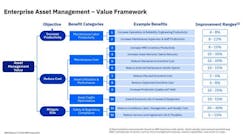Best Practices: Infrastructure Asset Management: Leveraging the Benefits of Integrated Systems
ALEXANDRIA, VA - Managing infrastructure assets can be surprisingly complex to those unfamiliar with the transportation industry. A road is not “just a road” but rather a collection of components that each contribute to a seamless and safe driving experience. For example, the I-95/I-395 Express Lanes in Northern Virginia managed by Transurban, a global toll-road operator and infrastructure developer, is a 39-mile-long roadway that has 14,300 components, including 11,185,000 square feet of asphalt pavement, bridges/overpasses, streetlights, control gates, cameras, detectors, generators, fiber optic networks and dynamic message signs.
Transurban operates and maintains the Washington-area Express Lanes in collaboration with the Virginia Department of Transportation (VDOT) through a public-private partnership (P3). P3s can be an important tool for governments that are looking for cost-effective and low-risk ways to manage infrastructure assets. These types of partnerships allow private capital to be leveraged for public goods and puts the responsibility of management on the private operator rather than the local DOT, offsetting taxpayer expense through maintenance and operations.
Improving infrastructure is often a reactive process, but there are benefits to adopting a proactive approach. When approaching the management of the express lanes, Transurban recognized the need for and value to be derived from using a centralized asset management (CAM) platform.
Optimizing the asset’s life cycle is best done through a centralized system that catalogs the full component inventory, layers in real-time information and optimizes proactive maintenance to preempt more costly and extensive future maintenance needs. Real-time monitoring includes tracking the physical and environmental conditions around the asset, like severe weather, traffic collisions or unexpected roadway hazards.
Benefits of a proactive asset management approach include improved road safety, operational and maintenance cost savings and minimized future risks.
Best practice approach to CAM
To centralize asset management, an organization needs to manage its assets and routinely inspect the components. Efficient systems include scenario planning, real-time condition monitoring, scheduling capabilities and asset management that integrates with the corporate model.
Asset management systems are often modular, scalable and can be tailored to the organization. A robust system may include facilities, warehousing, fleet management, procurement and financial accounting. A smaller system may only address facilities. The system workflow may also be adjustable to reflect an existing workflow.
Ultimately, the tool that Transurban chose to implement for a centralized approach is IBM’s Maximo. The chart that appears at the top of this page from IBM showcases the value that such a tool can bring.
Since infrastructure assets spread across a large area, three initial challenges must be considered to implement a centralized management system:
1. Is there an accurate inventory of the asset?
2. What is needed to continue operations with minimal downtime?
3. What are the real-time conditions and the life cycle of the asset?
Creating an accurate asset inventory is essential, including everything from a list of the resources to all the components. This inventory allows all elements to be tracked and manages how the components are operating.
Through its asset management platform, Transurban configured its organizational standards and procedures into the platform and created an inventory of the different moving parts (collectively called the asset); the first steps to effective asset management.
The proactive maintenance model ensures clients’ experience is consistent and reliable, with continuing operations. Tracking maintenance requests, prioritizing road work and analyzing live updates to repairs not only improves safety but also provides accelerated responsiveness, long-term cost savings and insights into the life cycle of an asset.
The real-time conditions of the asset are another challenge that can be improved with an integrated management system. The road conditions – cracked asphalt, potholes, offline detectors – require quick coordination and efficient repairs, which can be detected and resolved quickly with artificial intelligence (AI) and machine learning capabilities. With the knowledge of real-time updates, asset managers track irregularities and address them proactively to avoid surprises in the future.
Plan proactively
Constructing one mile of road has the potential to cost millions, so efficiently managing the life cycle of components is critical for both the organization and its customers.
Drivers expect a consistent experience on the roads, so thinking proactively ensures that the infrastructure assets perform at a specific level and that all resources are accurately inventoried and properly maintained. Thousands of components work together to contribute to a seamless driving experience, and a centralized asset management platform identifies the risks before they become long-term problems.
The costs of implementing an asset management system can be considerable, but the return on investment can be substantial. When working with a private partner, there are long-term cost savings for local governments as companies like Transurban handle the ongoing management and maintenance of the asset and the platform.
-----------
Samrat Valani is senior director of asset operations for Transurban North America.
About the Author

